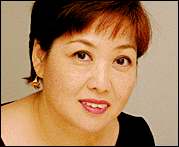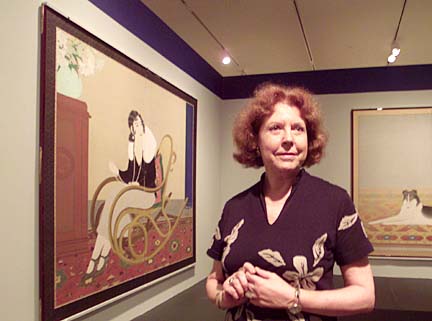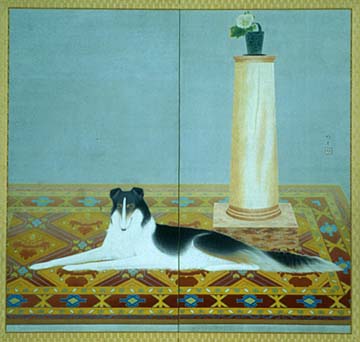


Local Color![]()
Sunday, February 3, 2002

|
The fact that her charm school in Tokyo was a miserable failure wasn't the reason Patricia Salmon turned to collecting Japanese art. The connection is subtle and intriguing. West met East, and the result
was a charming successThe results of her two decades of combing Japanese antique stores, auction houses and galleries are on display at the Honolulu Academy of Arts. "Taisho Chic: Japanese Modernity, Nostalgia and Deco," art reflecting Western influences in the first half of the 20th century, is on view through March 17 in the Luce Pavilion Gallery.

|
Salmon, a San Antonio native, had fallen in love with Asia when she visited the region regularly as a flight attendant for Pan American World Airways. Although she later became the secretary to the president of a major Los Angeles record company, she was restless and thought of returning to Asia.A television documentary about the Land of the Rising Sun gave her the idea to move to Japan to take advantage of the country's post-World War II revival. The documentary mentioned charm schools were in vogue, as the Japanese were eager to learn Western manners and customs.
"I said, 'Goodie, I can do that,' and off I went like Pollyanna, thinking it was all going to work out," said Salmon, who had worked as a model and taught charm and modeling classes while earning a degree in speech and drama at Trinity University.
Through introductions she found a Japanese partner, and she opened her charm school in 1961. Things were looking up when the wife of her partner brought five of her friends to attend the first class.
"But they came once and they never came back," recalled Salmon. "The whole thing was a flop."
The Japanese women were uncomfortable with her American style of teaching, which demanded one-on-one interaction between teacher and student in small classes. Large classes and lectures were the norm in the Japanese charm schools.
That was her first cultural shock, and it got her attention. Despite her initial failure, Salmon became quite successful in other business ventures. Her charm school evolved into a booming modeling agency supplying foreign models for Japanese export advertisements. She was the host of a television program called "Charm Corner," dispensing Western beauty secrets and etiquette to a Japanese audience. She hosted a radio program, "From a Woman's Point of View," that gave her the opportunity to interview celebrities and political leaders.
Salmon also wrote a weekly fashion and beauty column for the Mainichi Daily News for 10 years. But while she established a thriving multifaceted career, Salmon continued to find the cultural gap difficult to master.

|
"Whenever I came up with a good idea, I'd present it ... and the Japanese people would be very polite. I always thought they liked my idea, but my translator said, 'Forget it,'" Salmon said.When her proposals were met with knotted brows and discouraging remarks, the news actually was good. "When they ask questions and see problems, that meant your ideas were well received and they were thinking about implementing them," Salmon said.
Through the years her business dealings taught her about the Japanese psyche, but her best teacher was antique shopping, which led to a career change to art.
"I always was interested in collecting Asian antiques. I was intrigued by what the objects were used for, how they were used, why they were made. I found I could learn about the culture and the history through the antiques," Salmon said.
She sold her charm school in 1970 and turned her attention to serious study of Asian art and antiques. She wrote a column for Mainichi Daily News and other articles and published her book, "Japanese Antiques," in 1975. The following year, she became a partner in the Gallery, an antique shop specializing in Asian antiques.
Her new career gave her ample opportunity to scrutinize various art forms, and she was drawn especially to art created in the first half of the 20th century, when all aspects of Japanese culture embraced Western influences.
"I found that art of this period was a mix of the East and the West. It was still very Japanese but it was modern. It's very appealing to me," Salmon said.
Women, often in Western clothes and settings, became favored subjects in paintings. Designs from this period show an inclination toward Art Deco motifs with strong geometric patterns and Western colors.
The academy's exhibition features screens and paintings purchased from Salmon as well as objects donated by her. The show also includes the academy's exquisite collection of textiles (see Page G12 for kimonos) and woodblock prints from Philip Roach Jr. More woodblock prints from the Roach collection is being shown separately at the academy.
Salmon sold her business interests in Japan and moved to the Big Island in 1989. She continues to collect art and also is working on a novel based on Japanese history.
Place: Luce Pavilion Gallery, Honolulu Academy of Arts, 900 S. Beretania St. "Taisho Chic: Japanese Modernity, Nostalgia and Deco"
Time: 10 a.m. to 4:30 p.m. Tuesday through Saturday, 1 to 5 p.m. Sunday, through March 17
Admission: $7; $4 to seniors, students and military; free to members and children 12 and under; free the first Wednesday of each month
Call: 532-8700
Gardening Calendar
Suzanne Tswei's art column runs Sundays in Today.
You can write her at the Star-Bulletin,
500 Ala Moana, Suite 7-210, Honolulu, HI, 96813
or email stswei@starbulletin.com